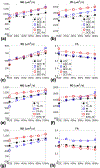Oscillating diffusion-encoding with a high gradient-amplitude and high slew-rate head-only gradient for human brain imaging
- PMID: 32011027
- PMCID: PMC7180099
- DOI: 10.1002/mrm.28180
Oscillating diffusion-encoding with a high gradient-amplitude and high slew-rate head-only gradient for human brain imaging
Abstract
Purpose: We investigate the importance of high gradient-amplitude and high slew-rate on oscillating gradient spin echo (OGSE) diffusion imaging for human brain imaging and evaluate human brain imaging with OGSE on the MAGNUS head-gradient insert (200 mT/m amplitude and 500 T/m/s slew rate).
Methods: Simulations with cosine-modulated and trapezoidal-cosine OGSE at various gradient amplitudes and slew rates were performed. Six healthy subjects were imaged with the MAGNUS gradient at 3T with OGSE at frequencies up to 100 Hz and b = 450 s/mm2 . Comparisons were made against standard pulsed gradient spin echo (PGSE) diffusion in vivo and in an isotropic diffusion phantom.
Results: Simulations show that to achieve high frequency and b-value simultaneously for OGSE, high gradient amplitude, high slew rates, and high peripheral nerve stimulation limits are required. A strong linear trend for increased diffusivity (mean: 8-19%, radial: 9-27%, parallel: 8-15%) was observed in normal white matter with OGSE (20 Hz to 100 Hz) as compared to PGSE. Linear fitting to frequency provided excellent correlation, and using a short-range disorder model provided radial long-term diffusivities of D∞,MD = 911 ± 72 µm2 /s, D∞,PD = 1519 ± 164 µm2 /s, and D∞,RD = 640 ± 111 µm2 /s and correlation lengths of lc,MD = 0.802 ± 0.156 µm, lc,PD = 0.837 ± 0.172 µm, and lc,RD = 0.780 ± 0.174 µm. Diffusivity changes with OGSE frequency were negligible in the phantom, as expected.
Conclusion: The high gradient amplitude, high slew rate, and high peripheral nerve stimulation thresholds of the MAGNUS head-gradient enables OGSE acquisition for in vivo human brain imaging.
Keywords: diffusion imaging; head-gradient; microstructure.
© 2020 International Society for Magnetic Resonance in Medicine.
Figures






Similar articles
-
Diffusion time dependency along the human corpus callosum and exploration of age and sex differences as assessed by oscillating gradient spin-echo diffusion tensor imaging.Neuroimage. 2020 Apr 15;210:116533. doi: 10.1016/j.neuroimage.2020.116533. Epub 2020 Jan 11. Neuroimage. 2020. PMID: 31935520
-
Peripheral nerve stimulation limits of a high amplitude and slew rate magnetic field gradient coil for neuroimaging.Magn Reson Med. 2020 Jan;83(1):352-366. doi: 10.1002/mrm.27909. Epub 2019 Aug 6. Magn Reson Med. 2020. PMID: 31385628 Free PMC article.
-
Improved gradient waveforms for oscillating gradient spin-echo (OGSE) diffusion tensor imaging.NMR Biomed. 2021 Feb;34(2):e4434. doi: 10.1002/nbm.4434. Epub 2020 Oct 29. NMR Biomed. 2021. PMID: 33124071
-
Engineering clinical translation of OGSE diffusion MRI.Magn Reson Med. 2025 Sep;94(3):913-936. doi: 10.1002/mrm.30510. Epub 2025 May 7. Magn Reson Med. 2025. PMID: 40331336 Free PMC article. Review.
-
Connectome 2.0: Developing the next-generation ultra-high gradient strength human MRI scanner for bridging studies of the micro-, meso- and macro-connectome.Neuroimage. 2021 Nov;243:118530. doi: 10.1016/j.neuroimage.2021.118530. Epub 2021 Aug 28. Neuroimage. 2021. PMID: 34464739 Free PMC article. Review.
Cited by
-
Comprehensive characterization of tumor therapeutic response with simultaneous mapping cell size, density, and transcytolemmal water exchange.ArXiv [Preprint]. 2024 Aug 4:arXiv:2408.01918v1. ArXiv. 2024. Update in: Magn Reson Imaging. 2025 Oct;122:110433. doi: 10.1016/j.mri.2025.110433. PMID: 39130198 Free PMC article. Updated. Preprint.
-
Probing neural tissues at small scales: Recent progress of oscillating gradient spin echo (OGSE) neuroimaging in humans.J Neurosci Methods. 2021 Feb 1;349:109024. doi: 10.1016/j.jneumeth.2020.109024. Epub 2020 Dec 14. J Neurosci Methods. 2021. PMID: 33333089 Free PMC article.
-
Recent Advances in Compact Portable Platforms and Gradient Hardware for Brain MRI.Radiology. 2025 Jun;315(3):e241904. doi: 10.1148/radiol.241904. Radiology. 2025. PMID: 40492919 Review.
-
Mapping the human connectome using diffusion MRI at 300 mT/m gradient strength: Methodological advances and scientific impact.Neuroimage. 2022 Jul 1;254:118958. doi: 10.1016/j.neuroimage.2022.118958. Epub 2022 Feb 23. Neuroimage. 2022. PMID: 35217204 Free PMC article. Review.
-
Improving MR cell size imaging by inclusion of transcytolemmal water exchange.NMR Biomed. 2022 Dec;35(12):e4799. doi: 10.1002/nbm.4799. Epub 2022 Jul 28. NMR Biomed. 2022. PMID: 35794795 Free PMC article.
References
Publication types
MeSH terms
Grants and funding
LinkOut - more resources
Full Text Sources
Medical
Miscellaneous

